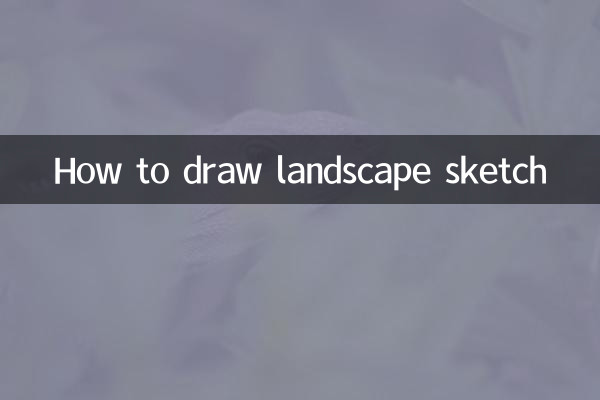How to draw landscape sketch
Landscape sketching is one of the basic techniques in painting, which expresses the beauty of natural scenery through simple lines and the relationship between light and shade. Whether you are a beginner or a painting enthusiast with a certain foundation, mastering the skills of landscape sketching can improve the expressiveness of your works. The following is a collection of tips and key points related to landscape sketching that have been popular topics on the Internet in the past 10 days to help you get started quickly.
1. Basic tools for landscape sketching

To draw a landscape sketch, you need to prepare the following basic tools:
| Tool name | Purpose |
|---|---|
| Pencil (2B-6B) | Used to outline and express light and shade |
| sketch paper | Choose paper with a moderate texture to facilitate line expression |
| Rubber (plastic rubber) | Modify lines or brighten highlights |
| pencil sharpener | Keep the pen tip sharp for easy drawing of details |
2. Composition Techniques of Landscape Sketching
Composition is the key to landscape sketching, and a reasonable composition can make the picture more attractive. The following are common composition methods:
| Composition method | Description |
|---|---|
| rule of thirds | Divide the picture into three equal parts and place the subject at the intersection point |
| foreground, middle shot, long shot | Enhance the sense of space through layering |
| leading line | Use natural lines (such as rivers, roads) to guide the eye |
3. Steps of drawing landscape sketch
Here are the general steps for drawing a landscape sketch:
| steps | Operational points |
|---|---|
| 1. Observation and framing | Choose an angle of interest and pay attention to light and shadow |
| 2. Lightly trace the outline | Use a light-colored pencil to outline the general shape of the main scene |
| 3. Refine the structure | Add details such as tree branches and building textures |
| 4. Express light and dark | Express the relationship between light and shadow through arranging or smearing |
| 5. Adjust the overall | Check the balance of the picture and strengthen the key parts |
4. Frequently Asked Questions and Solutions
Beginners may encounter the following problems when sketching landscapes:
| question | Solution |
|---|---|
| The picture is dull | Add dynamic lines or change the size of the scene |
| Not enough space | Enhance the blurring of distant views and the contrast of close shots |
| Shadow clutter | Unify the direction of light sources and simplify shadow levels |
5. Improve landscape sketching skills
If you want to further improve your landscape sketching skills, you can try the following methods:
1.Observe nature more: Pay attention to the light changes and scene characteristics at different times.
2.Practice sketching: Quickly capture the dynamics and instant impressions of scenery.
3.Study the works of masters: Analyze composition and techniques in classic sketches.
4.Try different tools: Such as charcoal, pen, etc., to enrich the expression effect.
6. Recent popular landscape sketch topics
According to the hot content on the Internet in the past 10 days, the following are the focus of discussion on landscape sketching:
| topic | heat index |
|---|---|
| How to use sketch to express the changes of the four seasons | ★★★★☆ |
| Urban landscape sketching techniques | ★★★☆☆ |
| Digital tools combined with traditional sketching | ★★★★★ |
Through the above content and techniques, I believe you will have a clearer understanding of how to draw landscape sketches. Whether it is outdoor sketching or copying exercises, persistence in practice is the key to improving your sketching skills. Pick up the brush and start your landscape sketch creation!

check the details

check the details